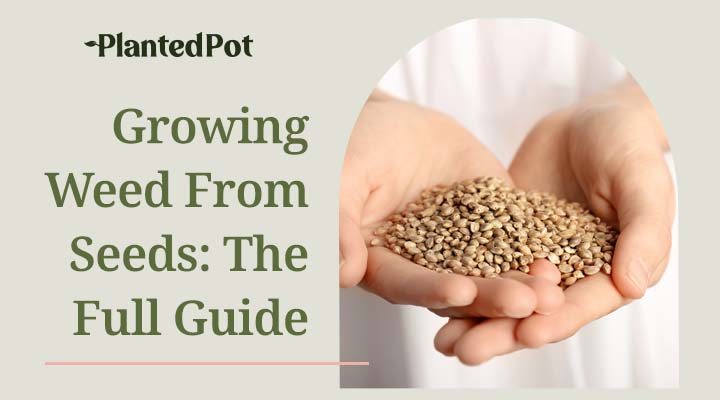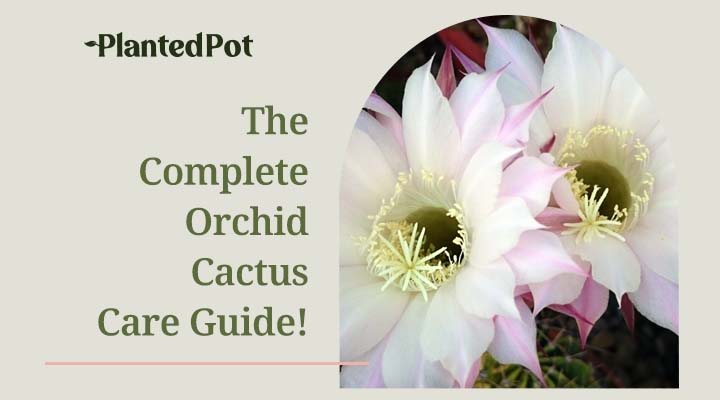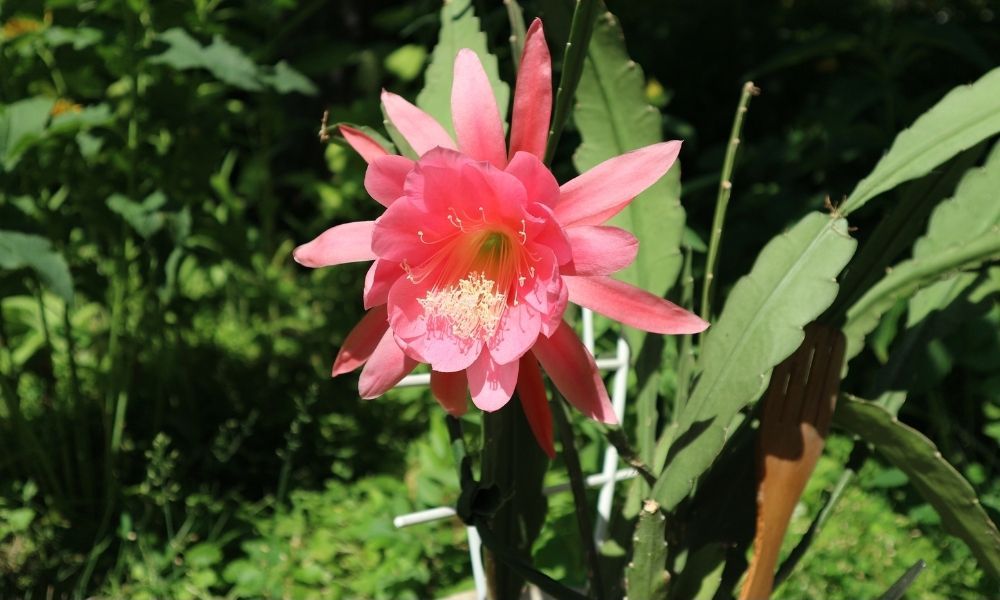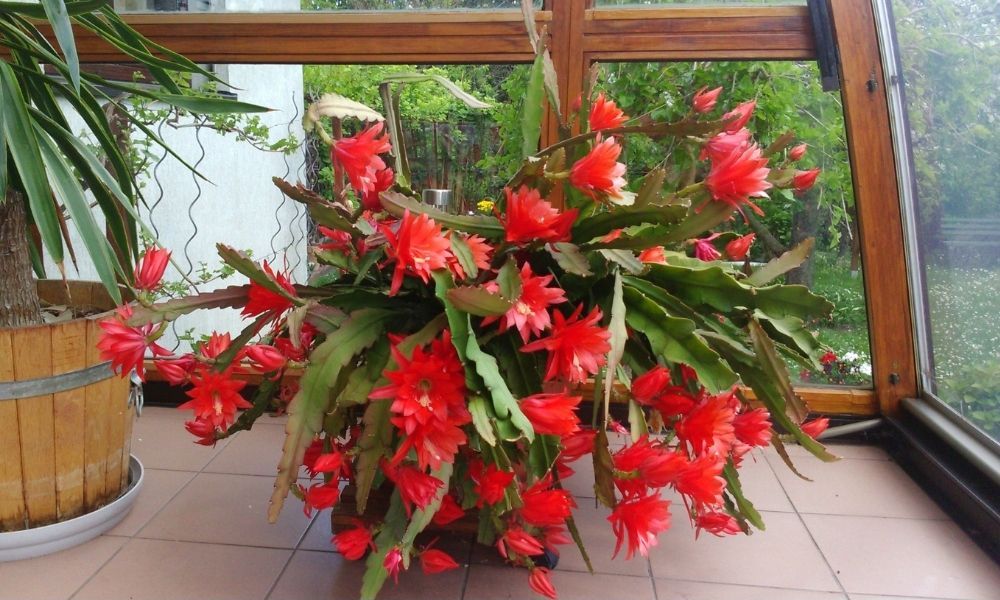
Orchid Cactus Care: The Secret to Vibrant Blooms [Complete Guide]
Home / Orchid Cactus Care: The Secret to Vibrant Blooms [Complete Guide]

Orchid Cactus Care: The Secret to Vibrant Blooms [Complete Guide]
- Kyle Chin
- March 3, 2021
- 10:29 pm
- No Comments
You might think that orchid flowers are too pretty to sit atop a prickly cactus. Well, we’re here to prove you wrong! The orchid cactus is not the thorny plant you might be imagining. This beautiful, exotic jungle native dazzles everyone that lays eyes upon it. And even better, orchid cactus care is simple.
Many gardeners prize the orchid cactus for its color, size, and fragrance. This beautiful indoor plant can adapt to many environments and is easy to maintain — good news for all you busy and forgetful plant parents out there. Needless to say, the orchid cactus can be a great addition to your household.
In this guide, we will cover everything you need to know about how to care for your orchid cactus at home. Find out how you can make this plant your next colorful centerpiece!
What is an Orchid Cactus?
The orchid cactus (Epiphyllum) is a flowering cactus plant native to Southern Mexico. You can find this plant in tropical forests all over Central and South America. Orchid cacti usually thrive in humid, jungle environments. People often confuse the bright-colored flowers for orchids, but the plant has sharp, serrated stems that make it a type of cactus.
Many orchid cactus enthusiasts call the plant by its scientific name “Epis.” The stunning flowers of this tropical cactus usually bloom every year around springtime. The flowers typically last for only several weeks, so be sure to enjoy them while it lasts!
Orchid cacti have a wide variety of bright bloom colors, all with different fragrances and forms. The beautiful colors of the orchid cactus can include:
- Red
- Orange
- Yellow
- Purple
- Pink
- White
- Bi-color
Orchid cacti can also produce edible fruit! Some people describe the taste as similar to passionfruit or kiwi, having a soft texture and an amazing sweetness to it. In some cultures, people use its flowers as a soup ingredient for the tantalizing aroma.
Is an Orchid Cactus Easy to Care For?
Yes, orchid cacti are very easy to grow! They can adapt to most environments and don’t require constant attention to grow beautifully. Still, you can still do a few things to help the blooms turn out perfect and stunning.
Can You Grow an Orchid Cactus Indoors and Outdoors?
Yes, you can grow an orchid cactus both indoors and outdoors! Orchid cacti are unique plants that absorb moisture in the air to grow. They love warmth but need cooler temperatures for their flowers to bloom. Average indoor humidity is usually the perfect condition for the orchid cactus to grow.
Also, orchid cacti make excellent hanging plants that can grow both indoors and outdoors. They will grow larger if you hang them outside, but they grow perfectly fine indoors as well. They can adapt to both dry and humid environments.
What Are the Benefits of an Orchid Cactus?
On top of its beauty and floral aroma, orchid cacti are a source of food for animals and humans. Like all plants, the orchid cactus absorbs carbon dioxide and recycles it into oxygen, cleansing the air for all organisms around it. Having a few of these plants around the house can act as a natural air purifier!

How to Care for an Orchid Cactus
Creating the perfect conditions for your orchid cactus can help it bloom beautifully. Finding the right pots, knowing how often to water, using the best fertilizer, and giving it the right amount of sunlight and the ideal temperature can affect its growth.
Finding the Right Pot
When looking for a pot for your orchid cactus, start with a smaller planter or pot. The pot must have good drainage since an excess of water or moisture can cause the plant to wilt or die. Terracotta or clay pots are excellent choices since they are porous and allow moisture to evaporate from the soil.
When planting an orchid cactus, try to do it when the plant is not blooming. Wait at least a month after the flowers die to replant your orchid cactus.
Since the orchid cactus’s stems can grow up to 10 feet long, hanging baskets/pots are often a popular choice for potting. If the plant is grown indoors, the stems will be slightly shorter, around 2-3 feet long.
Choosing the Right Soil
Use well-draining soil for your orchid cactus so it does not hold water in. Pre-made cactus potting soils can sometimes be too gritty and rough for your orchid cactus. You can create a custom potting mix using:
- 3 parts regular potting soil
- 1 part perlite or pumice
- 1 part peat-moss potting mix
A slightly more acidic potting mix can also help the orchid cactus grow better. Aim for about a pH level of 6.
RELATED: BEST SOIL FOR CANNABIS
Watering an Orchid Cactus
Overwatering any cactus can damage or even kill the plant, so be sure to water sparingly. However, the roots of the orchid cactus should be kept moist to ensure the plant’s survival. Allow the top third of the soil to dry out before watering again.
During wintertime, plants are usually more dormant and require less water. You can keep the soil moist (but not oversaturated) during the blooming seasons of spring to fall and then water sparingly until the next season.
It’s best to use lukewarm water as orchid cacti are more sensitive to temperature changes. Chilly water can shock the roots.
Placement and Lighting
Orchid cacti thrive with indirect sunlight, much like their jungle and rainforest environments. Orchid cacti are known as “shade plants,” which receive filtered sunlight through the leaves of the trees above them. Do not allow direct sunlight to hit this plant, or else the heat and overexposure can damage the flowers and stems.
A few signs that your orchid cactus may not be getting enough sunlight are yellow or wilted leaves. If your plant looks “leggy” or stretched, it may be trying to grow towards the sunlight. A healthy orchid cactus will have light to dark green stems with slight red tints around the edges.
Pruning Your Orchid Cactus
Typically pruning is only done to control your orchid cactus’ size, especially if it is grown indoors. Wait until after the flowers have died to start trimming away. Make sure to sure clean sharp cutters or shears to prevent the stems from tearing. After pruning, your plant won’t need as much water to grow. It is important not to overwater after you have trimmed your plant.

Humidity and Temperature
Orchid cacti grow best in normal room temperatures of about 65-75°F. However, during the winter seasons, they need cooler temperatures so the flower buds can lay dormant and bloom later. The optimal winter temperatures should be about 5-10° lower, around 60-65°F.
The ideal humidity for the orchid cactus is about 40-50%, which is typical of regular households. This plant can still grow with less humidity, but you can also use a humidifier or place the plant over wet rocks to create a moist atmosphere.
Feeding an Orchid Cactus
During the growing seasons (spring to fall), you can feed your orchid cactus once every two weeks. Use a 10-10-10 fertilizer (10% phosphate, 10% nitrogen, 10% potassium) for best results. Avoid using a fertilizer that has more than 10% nitrogen in the blend.
Right before the flowers bloom in springtime, you can use a 2-10-10 fertilizer mix to encourage flowering. After the blooming season is over and the flowers have died, stop fertilizing until the next growing season.
How to Make an Orchid Cactus Bloom
The key to getting an orchid cactus to bloom is allowing it to rest during the winter for about 8-10 weeks. This rest period allows the flower buds to set and prepare to flower come springtime. Give the buds a few hours of natural indirect sunlight during the day and then move to a dim or dark room at night.
Try to limit the plant’s exposure to artificial light. The artificial light may trick the plant into thinking it’s receiving more sunlight, and this will throw off its bloom cycle. The plant needs to experience long, dark winter “nights” for the buds to stay dormant and rest. High phosphorus fertilizer can also encourage blooming and flower growth. Remember to start feeding in early spring so there is enough time for the flowers to bloom.
The great thing about orchid cacti is that they don’t need constant attention and care. In fact, it may be better to leave them alone so that they can grow freely. Try to avoid temperature changes, such as placing it next to fans, air conditioning units, or heaters.
Common Orchid Cactus Care Issues
Here are some common issues that people encounter when caring for their orchid cactus:
- Overwatering – A common myth is that more water equals more growth. But, overwatering can cause plant or root rot, which may lead to plant death. If the stems start to turn black or brown, cut back the watering and trim off the rotting sections.
- Too much or too little light – Too much light can cause the plant to turn yellow or look wilted. Not enough light can lead to sagging or a leggy appearance.
- Pests or insects – Plants can sometimes attract pests like mealybugs, aphids, or spider mites, especially if they grow outdoors. You can use insecticide soap or rubbing alcohol to remove the insects and keep your plant clean.
- Fungus – Fungus can result from overwatering or excess moisture. Typically, you will notice spotting on the stems. Let the soil dry out in the sun and cut away the affected areas to remove the fungus.
How Do I Know if My Orchid Cactus is Dying?
If you notice any discoloration or stunted growth in your orchid cactus, it may be a sign that your plant is dying. If you are having trouble diagnosing the issue, you can take the cactus out of the pot and examine the roots. Afterward, repot with new soil.
Orchid cacti are usually well-rooted plants, so if the root and stems feel loose, something may be affecting its growth. Always remove dying or wilted parts of the plant so the cactus can focus on growing the healthy areas.
Are Orchid Cacti Poisonous?
No, orchid cacti are not poisonous or toxic! The stems or flowers are generally not meant to be eaten, but they do not pose an immediate health risk if accidentally ingested by small children or pets.
Final Thoughts
The orchid cactus is a beautiful plant that is great for indoors and outdoors. The beautiful shades of color, long-hanging stems, and pleasant floral fragrances can add a touch of beauty to your home. Why not make the orchid cactus your next houseplant?



